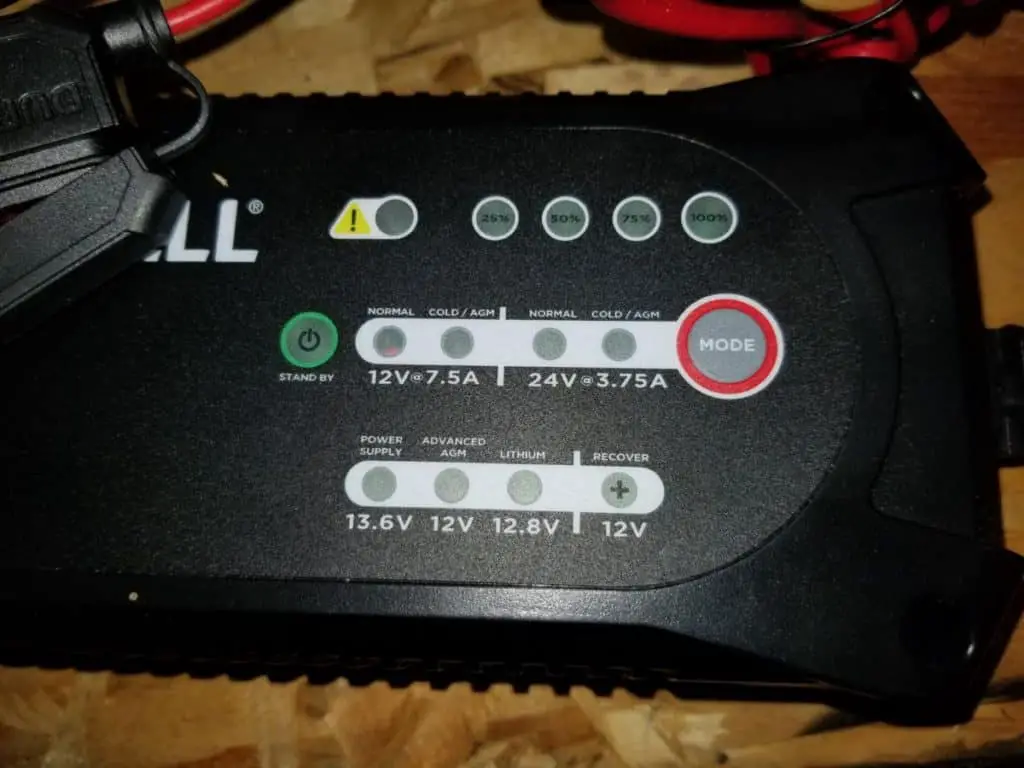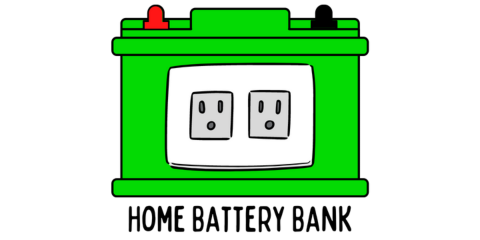I was at work last week and my maintenance co-worker admitted that he wasn’t quite sure of the difference between a float and a trickle charger. It reminded me of the research that I had done when I first built my backup home battery bank. I was terrified to ruin $250 worth of batteries by choosing the wrong charger!
Float chargers are microprocessor-controlled and will only charge a battery when it is able to accept a charge. A trickle charger continuously emits a small current, regardless of the battery’s ability to accept it, and leads to overcharging if left unchecked.
Trickle Charger vs. Float Charger (Maintainer)
| Trickle Charger | Float Charger (Maintainer) |
|---|---|
| Will charge a battery to 100% | Will charge a battery to 100% |
| Will overcharge a battery after it reaches 100% | Only outputs current as the battery naturally self-discharges and can accept a current |
| Will kill a battery if left connected to a battery long-term | Safe to hook up and use indefinitely |
That is the quick and easy answer, and it may seem like it doesn’t matter which one you choose. Don’t be fooled, however, as these chargers are not created equal and one can really damage your batteries if used improperly!
While both can effectively charge and top off your battery if used correctly, there are a few precautions you’ll want to take before hooking these up to your car or other battery and simply setting it and forgetting it.
If you’re just wondering what’s the best charger for the money in the “float/trickle” category, I always turn to this charger and float maintainer seen on Amazon. I’ve been using it every day on my battery bank and to condition my car batteries for over 6 years and I trust it 100%. I’ll get to the reasons below why this float charger is the way to go, but if you’re just in a hurry I highly recommend giving it some consideration.
Below is a video I made going over the differences between the different chargers.
What is a Trickle Charger?
A trickle charger will never stop sending a battery a low emission of electrical current. Even though the battery is 100%, the trickle charger will continue to try to pack more energy into it.
If you had a lithium-ion battery (like on a cell phone), this wouldn’t be a problem. However, if you’re dealing with a lead-acid battery (sealed, or otherwise) like in your car, motorcycle, golf-cart, lawnmower, boat, or battery bank, you’re at very high risk of damaging your batteries in the long-term if you leave them hooked up to a trickle charger.
Trickle chargers that are on the cheap end of the spectrum can even destroy batteries overnight if left connected.
Also keep in mind that even though a true “trickle charger” is different than a float charger, the majority of people use the term “trickle charger” to denote any charger that you can leave connected to a battery indefinitely.
Why can a Trickle Charger be Dangerous?
The reason that a trickle charger can damage a battery if hooked-up for a long time can be explained by what happens when a battery charges.
Without getting too complicated, a battery receives electricity from a charger. The electricity passes between the positive and negative terminals of the battery, by the plates, and through an electrolyte solution (the battery acid). As the electricity passes through this solution, a chemical reaction occurs, the chemical structure changes, and potential energy is stored.
When a battery is very low on charge, say 40%, it can accept a higher amp charge and readily convert the electrical energy into potential chemical energy (that can then be released as electricity when a circuit is completed). As the battery approaches its full charge, it cannot accept as much electricity because it is running out of capacity to store it.
Cramming too much electricity (amps, in the case of a charger) will result in the battery converting as much as it can into storable energy, but the rest has to go somewhere.
The excess electricity is dealt with through a process called hydrolysis. This means that as the excess electricity passes through the electrolyte solution, it causes the hydrogen and oxygen molecules within the battery acid to break down, evaporate, the battery to heat up, and sulfation to occur on the lead plates inside the battery.
Essentially, electricity that is pumped into a battery when it can no longer accept it will destroy the water molecules in the battery acid. When this happens for a long time, the battery acid levels will drop due to evaporation, the lead plates will sulfate and can be exposed (which will cause irreparable damage), and the chemistry in the battery changes for the worse.
This is the reason why hooking up a trickle charger to a battery and leaving it for days or months on end can destroy your battery and even overnight in some cases. Even though the amp level might be very low, and even though you might not hear the battery bubbling, a less than desirable chemical reaction is occurring if you leave your battery on a trickle charge.
Can I use a Trickle Charger Safely?
Yes, you can certainly use a trickle charger in a safe manner, and it simply involves unplugging and disconnecting the trickle charger when your battery has reached a full charge.
All batteries self-discharge (lose their charge just by existing over time). If you have a healthy battery, this process will be a slow one. If you need to maintain a battery over a long period, simply hook it up to the trickle charger once a month or so, for a couple hours. Once it reaches 100%, unhook and give it a break for a few weeks.
If you are leaving your battery hooked up over the winter season and want to simply set it and forget it, you might want to consider the next type of charger that I’ll be talking about — the float charger.
What is a Float Charger (Battery Maintainer)?
A float charger is significantly different from a trickle charger in that it will top off a battery at 100%, cease further charging and remain on standby. As the battery naturally loses charge over time, the float charger will once again resume its charging to top the battery off and then switch to standby mode.
Due to this, batteries can be left hooked-up to a float charger for an indefinite period of time. Batteries work best when they are maintained at 100%, and a float charger is a perfect way to do this.

Do I Need to Buy a Task-Specific Float Charger or a Three-Stage Charger with a Float Mode?
When searching for a float charger, there are certainly very task-specific float chargers that only have a low amp rating and are designed specifically to supply a small current.
These chargers would be ideal for low to moderate daily use of a battery and nightly recharges.
There are, however, plenty of chargers on the market that have all of the benefits of a full and robust battery charger with plenty of amps, but then ramp down the amps when the battery nears its maximum charge level.
The distinction that needs to be made is that there are actual task-specific float chargers, but then there are battery chargers that have three distinct phases with the final one being a float mode.
Phases of a modern three-stage smart charger:
- Bulk (charge the battery from 0-80%)
- Absorption (charge from 80-95%)
- Float mode (95-100%)
I prefer to have an actual battery charger with a higher upfront amperage that can bring back a nearly dead battery in a decent amount of time but that is intelligent enough to switch to a lower amperage float mode and only top off my battery when it needs it.
If you’re looking for a fantastic battery charger and maintainer (with float mode, NOT trickle) that will keep your batteries constantly in prime condition and healthy without fear of overcharging, I recommend this charger from Amazon that I have been using for over 6 years without a single hiccup. It is a perfect “set it and forget it” charger that is perfect for something like car batteries (for overnight charging or long-term maintenance) and up to a small battery bank.
Due to this, batteries can be left hooked-up to a float charger for an indefinite period of time. Batteries work best when they are maintained at 100%, and a float charger is a perfect way to do this.
Related Questions
Will a Float Charger Charge a Dead Battery?
It depends on how dead the battery actually is. Modern smart chargers (float included) have a minimum voltage that the battery must possess in order for the battery to engage the charging process.
The microprocessor must sense that voltage in order to recognize that it is actually hooked up to a battery in order to begin the charging process. That is an inherent safety feature built into modern smart chargers.
If you’re looking for a float charger that can charge a dead car battery in a decent time, it is best to find a true battery charger with 5-15 amps that can do the majority of the charging and then switch over to a proper float mode (.75 to 2 amps, for example) when the battery is reaching its maximum capacity.
How Long Can you Leave a Car Battery on Trickle Charge?
Ideally, you should never leave your battery on a trickle charge after it has reached 100% capacity.
The occasional overnighter will likely result in an unobservable impact on your battery’s health and lifespan, but a high frequency of them or certainly an extended period like over the winter months will damage the overall efficacy of your battery’s performance.
If you find yourself leaving your battery hooked to a trickle charger longer than you should, it is best to check your acid levels regularly to keep them from getting too low.
If your levels are low but the plates are not exposed, make sure to bring your battery to a full charge before adding distilled water. Add just enough water to cover the plates if this is the case.
Then, after the battery is at 100%, add the appropriate amount of distilled water, and then charge once again to reach 100%.
Can you Overcharge a Car Battery with a Trickle Charger?
Yes, technically anytime your battery is hooked to a trickle charger after it has reached 100% capacity, it is overcharging and damaging your battery by evaporating water through hydrolysis, corroding the plates, and causing your battery to overheat.
An occasional day or two might not do too much, but try not to make it a habit if you don’t want to be replacing your batteries in less time than you would have otherwise.
Can you Trickle or Float Charge your Car Battery when it’s NOT Connected to the Vehicle?
Yes, you can hook up a trickle charger to your battery when it is either connected or disconnected from your vehicle. The battery will charge with the same results regardless of this factor.

Can I use a Battery Maintainer to Charge a Dead Battery?
A fully dead battery will not have the voltage needed for modern smart chargers with internal safety sensors to detect and will not charge, but an artificial jump from a healthy battery for a few minutes may provide the voltage needed to engage the charger and bypass the internal safety sensor to charge your battery.
The safety sensors exist so that a certain voltage must be detected before electricity flows through the cables. This is to prevent the charger from providing electricity to anything that you simply touch the two cables to.
